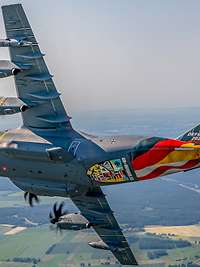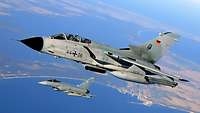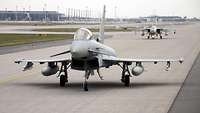
Air Defender 23
Multinational air operation exercise in Europe


25 nations are taking part in the Air Defender major exercise to train combined air operations. In a variety of smaller missions, the partners practice different capabilities required to establish air superiority and drive back an enemy.

Tornado and Eurofighter in formation: In composite air operations, combat aircraft with different capabilities are employed in combination
Bundeswehr/Stefan PetersenIt is only an exercise scenario, but it packs a punch: Air and ground forces of the enemy Occasus alliance occupy the fictional region of Klebius in eastern Germany – all in all, about a quarter of the country. In a next step, the units of the alliance plan to advance north to the Baltic Sea and capture a harbour. For this purpose, they use a combination of sabotage actions and special forces operations supported from the air. In the meantime, the Western Alliance has declared the state of defence in accordance with Article 5 of the NATONorth Atlantic Treaty Organization Treaty and has initiated the defence against this opponent, who is on par with friendly forces.
This is the initial situation of the Air Defender 23 major exercise. Armed forces from 25 nations participate in the fictional liberation operation with about 250 aircraft and roughly 10,000 servicewomen and servicemen. Operations are conducted from 26 locations, with the deployment of more than 100 aircraft of the USUnited States Air National Guard to Germany already being part of the exercise. The combat operations centre – the Joint Forces Air Command (JFACJoint Forces Air Component) – has already issued the first tactical order, i.e. the air task order. More than 200 individual missions and three combined air operations are to be expected per day. These composite air operations (COMAOs) are conducted by a combination of several aircraft types with different capabilities, such as reconnaissance aircraft, bomber aircraft, and tanker aircraft.
In this manner, traditional aerial strike forces are provided with additional forces for protection. This means primarily fighter aircraft, which are specialised in air-to-air engagements and thus defend friendly forces against enemy aircraft. In addition, electronic defence forces and reconnaissance forces can be integrated into these operations. The decisive factor, however, remains the coordinated interaction of different aircraft. This coordination is extremely demanding, as illustrated by the dimension of aircraft manoeuvres: Depending on the scenario, between 23 and 80 aircraft form part of one single COMAO during the Air Defender exercise.
The aircraft and pilots participating in the exercise assume different roles within the scenario – either those of friendly forces or those of the enemy. Accordingly, air interdiction is also part of the exercise scenarios. This includes air support using air-to-ground missiles to neutralise enemy air defence. Another item placed on the agenda as a capability gain is dissimilar air combat training. Here, different types of aircraft are employed against one another with and without support by radar control centres. Possible scenarios are operations beyond the enemy’s visual range and close-in dogfights. The Eurofighter aircraft involved assume the role of offensive air defence and use their multi-role capabilities to engage enemy aircraft and targets on the ground.

A Eurofighter and a Tornado aircraft in the manoeuvring area: Combat aircraft have different characteristics and capabilities that are combined in missions
Bundeswehr/Info BickerIn addition, suppression of enemy air defence (SEAD) missions are employed to neutralise enemy air defence. In the east, the German airspace is defended against enemy attacks. In the south, the forces fly offensive missions against the enemy in order to suppress enemy air defence so that friendly land forces can be supported by air operations and the employment of special forces, such as combat swimmers and paratroopers. Furthermore, a rescue mission must be accomplished in the south. And last but not least, the air-to-air refuelling capabilities are put to the test with 15 tanker aircraft tied in.
The Multinational Aircrew Electronic Warfare Tactics Facility – also referred to as Polygone – is also involved in the exercise. This trinational facility is located in France and Germany and commonly operated by the German Air Force, the French Armée de l'air, and the USUnited States Air Force. It trains aircrews in the use of their equipment for electronic warfare, in particular for threat situations caused by surface-to-air missiles.
The simulators used for training differ from real surface-to-air systems only in that they have a high-tech evaluation system installed. This feature allows the aircrews to be provided with detailed feedback on the missions carried out. The surface-to-air missile systems used for training are former systems of Russian and German design.
by Rüdiger Franz
Multinational air operation exercise in Europe